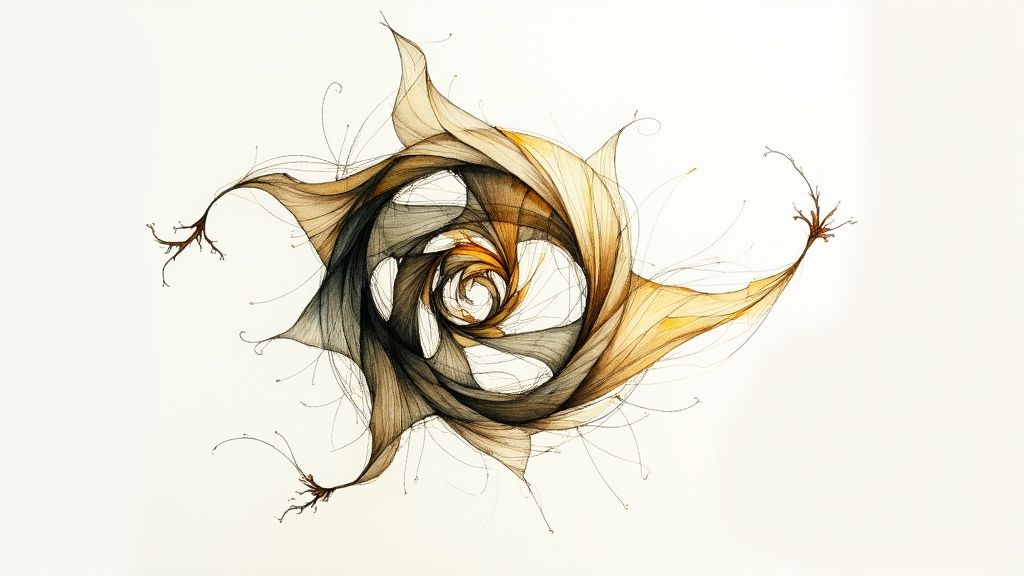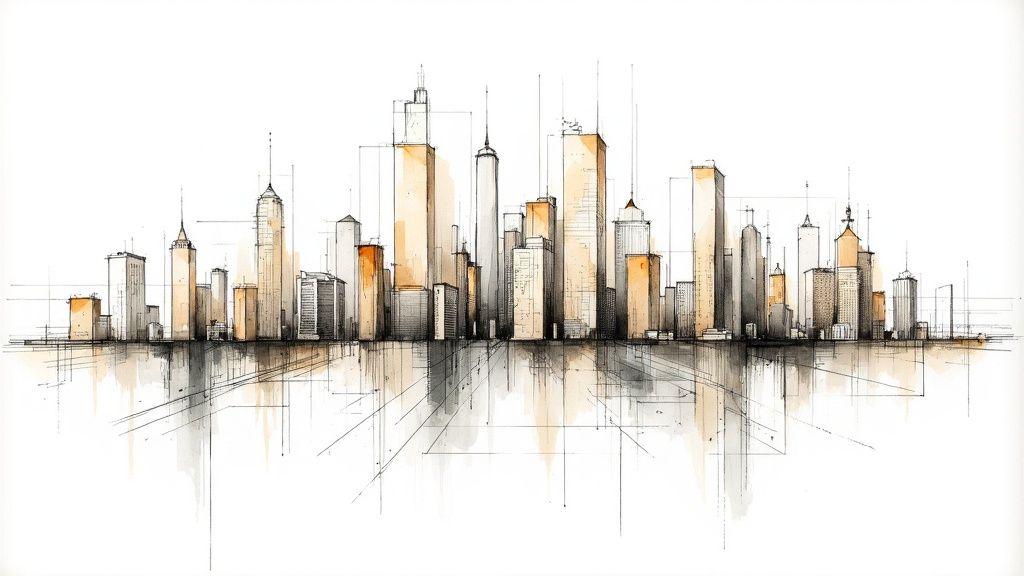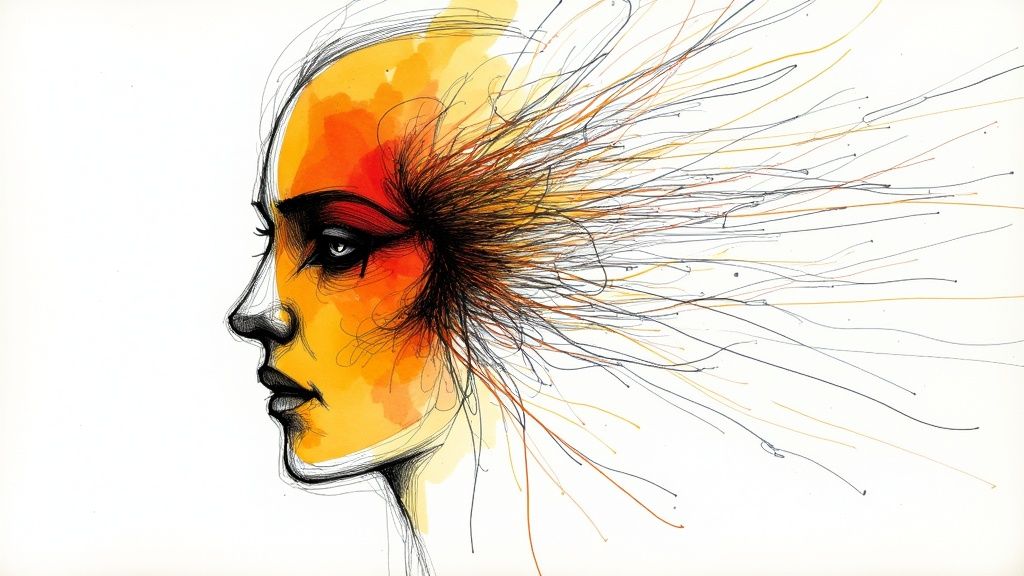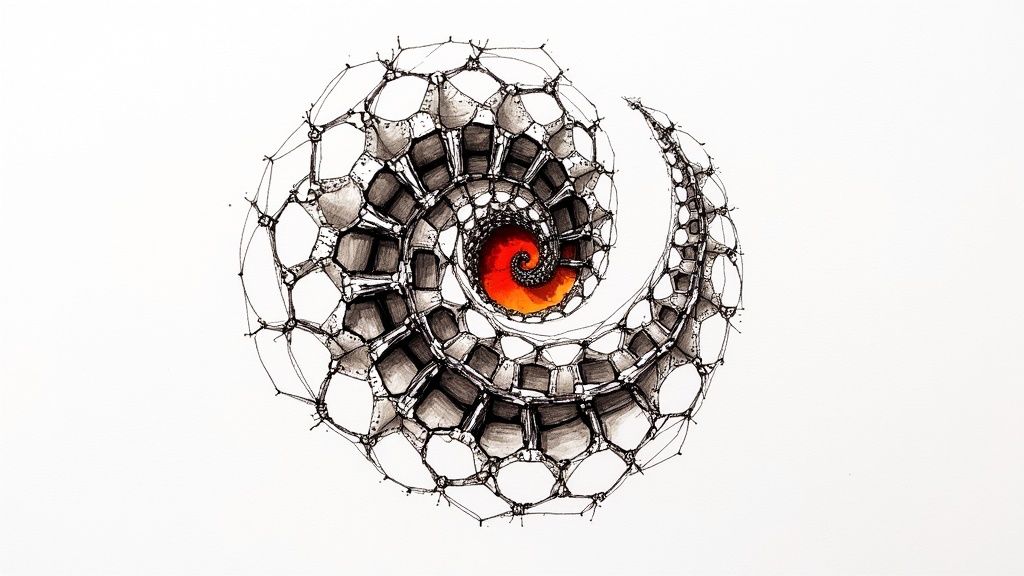Every artist, from the seasoned professional to the weekend hobbyist, eventually faces the blank page. The search for genuine, compelling inspiration for art can feel like a quest for a hidden treasure. While creative blocks are a natural part of the artistic journey, they do not have to be a permanent roadblock. The key is knowing where to look and how to translate the world around you, and within you, into visual expression.
This comprehensive guide moves beyond generic advice to explore ten diverse and powerful sources of creativity. Each section is designed to shatter your artistic block and fill your sketchbook with fresh, meaningful ideas. We provide specific, actionable strategies for each source, ensuring you have the practical tools to not just find inspiration, but to cultivate it consistently.
We will explore everything from the intricate patterns in nature to the raw energy of urban landscapes, and from the depths of your personal experiences to the universal language of music. Whether you are seeking a simple starting point or a profound theme for your next masterpiece, this list offers a structured path to unlock your creative potential. Let's dive in and discover how to find your next big idea.
1. Nature and Natural Forms
The natural world offers an infinite wellspring of creative ideas, making it a timeless source of inspiration for art. This involves observing and interpreting everything from vast landscapes and microscopic cells to the dynamic chaos of weather patterns. Artists can capture the realistic details of a plant or animal, or they can abstract the textures, colors, and structures found in nature to create something entirely new.

The power of this approach lies in its accessibility and diversity. Consider the soft, blended colors of a sunset in a Claude Monet painting versus the bold, magnified forms in Georgia O'Keeffe's flowers. Both draw from nature but yield vastly different artistic expressions. This versatility makes it an ideal starting point for artists experiencing a creative block or seeking to refine their observational skills.
How to Find Inspiration in Nature
To tap into this theme, engage with your environment directly. Go beyond simply looking at a scene and start actively studying its components.
- Keep a Nature Journal: Dedicate a sketchbook to drawing organic forms you encounter. Make notes on textures, colors, and how light interacts with surfaces like leaves or water.
- Focus on Micro-Details: Zoom in on a single element. Spend time sketching the intricate patterns of a snail's shell, the veins of a leaf, or the texture of tree bark.
- Study Natural Patterns: Explore recurring mathematical patterns found in nature, such as fractals in ferns, spirals in seashells, and the symmetry of a snowflake.
2. Urban Life and Architecture
The bustling energy of cityscapes, with their towering structures and human-centric stories, provides a powerful source of inspiration for art. This theme encompasses everything from grand architectural marvels and intimate street scenes to the textures of urban decay and the flow of daily life. Artists can document the precise lines of a modern skyscraper or capture the fleeting, moody atmosphere of a rain-slicked street at night.

The strength of this subject lies in its blend of rigid structure and dynamic human activity. Consider Edward Hopper's paintings, which convey a sense of urban solitude, versus the lively, candid moments captured in Vivian Maier's street photography. Both draw from the urban environment but evoke profoundly different emotions. This makes the city an excellent subject for artists wishing to explore themes of community, isolation, progress, and history.
How to Find Inspiration in Urban Environments
To harness this inspiration, immerse yourself in the city's fabric, paying attention to both the big picture and the small details. A dedicated urban sketching adventure can be a great way to start.
- Focus on Architectural Details: Instead of drawing a whole building, zoom in on an interesting element. Sketch a decorative entryway, a unique pattern of windows, or the texture of old brickwork.
- Capture the Human Element: Observe people as they interact with the city. Sketch commuters on a train, vendors at a market, or children playing in a park to add narrative to your work.
- Document Urban Contrasts: Look for areas where old and new coexist. Document the contrast between a historic building and a modern glass tower, or the process of urban decay and renewal.
3. Emotional States and Personal Experiences
The inner world provides a profound and deeply personal source of inspiration for art. This approach involves channeling emotions, memories, and psychological states directly onto the canvas or page. Instead of observing the external world, the artist turns inward, treating their own subjective experiences of joy, grief, anxiety, or peace as legitimate and powerful subject matter.

Art rooted in personal experience carries a unique authenticity and emotional weight. Consider the raw, confessional self-portraits of Frida Kahlo that explore physical and emotional pain, or Edvard Munch’s iconic work, The Scream, which visualizes a universal feeling of existential dread. This method is not about achieving technical perfection; it's about conveying a feeling with honesty and creating a resonant connection with the viewer.
How to Find Inspiration in Your Experiences
Tapping into your emotional landscape requires introspection and a willingness to be vulnerable with your art. The goal is to translate internal feelings into visual language.
- Keep an Emotional-Visual Journal: Instead of just writing about your feelings, try to represent them visually. Use colors, shapes, and lines that you intuitively associate with your emotional state at that moment.
- Explore Symbolism and Metaphor: You don't have to be literal. Think about symbols that represent a memory or feeling. A broken cage could symbolize newfound freedom, while tangled roots might represent deep-seated anxiety.
- Create Art in Different Moods: Don't wait for a "good" mood to create. Make art when you are sad, angry, or confused. This practice captures the full spectrum of human experience and can lead to powerful breakthroughs. If you're interested in this concept, you can explore ideas for drawing abstract emotions to get started.
4. Cultural Heritage and Traditions
Cultural heritage provides a deeply personal and meaningful source of inspiration for art. This involves exploring ancestral traditions, folklore, mythology, and historical narratives to inform creative work. Artists can either honor and preserve traditional art forms or reinterpret cultural symbols and stories within a modern framework, creating a powerful link between the past and present.

The strength of this approach comes from its authenticity and storytelling potential. Consider the intricate patterns of Indigenous Australian dot paintings, which convey complex spiritual beliefs, or the vibrant symbolism in Mexican Día de los Muertos art. Both draw from deep cultural roots to produce art that is both visually stunning and rich with meaning. This theme is ideal for artists seeking to connect with their identity or to tell stories that resonate on a profound level. For ideas on how to capture these moments, explore inspiration from a cultural festival scene.
How to Find Inspiration in Cultural Heritage
To tap into this theme respectfully and authentically, focus on research, connection, and thoughtful interpretation.
- Interview Family Members: Talk to relatives, especially elders, about their memories, stories, and traditions. Ask about folklore, family history, and significant cultural objects or practices.
- Study Traditional Techniques: Research the specific materials and methods used in your culture’s traditional art forms, such as Japanese woodblock printing or Native American beadwork.
- Blend the Old with the New: Find innovative ways to incorporate traditional motifs, patterns, or narratives into contemporary artistic styles. This creates a dialogue between history and your modern perspective.
- Show Respect and Give Credit: When borrowing from a culture, especially one that is not your own, it is crucial to research its context, understand its significance, and always credit the source.
5. Current Events and Social Issues
Art can be a powerful tool for dialogue, using creative expression to respond to contemporary political, social, and cultural issues. This approach transforms a creative practice into a vehicle for commentary, activism, and raising awareness. Artists engage with the world around them, interpreting events and movements to challenge perspectives and document history as it unfolds. This form of art is a vital part of the public conversation.
The strength of this approach is its relevance and immediacy. Consider Shepard Fairey's iconic Obama "Hope" poster, which captured the feeling of a political movement, or the provocative installations by Ai Weiwei that address human rights and censorship. Both artists translate complex societal issues into compelling visual statements. Using current events as inspiration for art not only provides a rich source of subject matter but also gives your work a profound sense of purpose.
How to Find Inspiration in Current Events
To effectively create art based on social issues, it is crucial to move beyond surface-level reactions and engage in deep, thoughtful exploration.
- Research and Understand: Dive deep into an issue that resonates with you. Read articles, listen to podcasts, and study different perspectives to ensure your artwork is well-informed and nuanced.
- Use Visual Metaphors: Complex ideas can be powerfully conveyed through symbolism. Think about how you can use metaphors and visual allegories to communicate your message without being overly literal.
- Consider Your Audience: Think about who you want to reach and the platform you will use. The message in a street art mural may be delivered differently than in a gallery piece or a digital illustration shared on social media.
6. Literature and Poetry
The written word provides a profound reservoir of inspiration for art, offering rich narratives, complex characters, and evocative imagery to translate into visual form. This involves more than literal illustration; it's about capturing the essence, mood, and thematic depth of a story or poem. Artists can explore the psychological state of a character, depict a pivotal scene, or create abstract works that channel the rhythm and emotion of poetic verse.
The power of this source lies in its ability to connect visual art with established emotional and intellectual frameworks. Consider William Blake’s haunting engravings for Dante's Inferno versus a modern graphic novel adaptation of a classic myth. Both draw from literature, yet one uses symbolic imagery while the other employs sequential storytelling. This approach is perfect for artists who thrive on narrative and want to explore themes like heroism, tragedy, and transformation through their work.
How to Find Inspiration in Literature
To translate text into compelling visuals, focus on interpretation rather than direct transcription. Immerse yourself in the world of the words and identify the core elements that resonate with you.
- Focus on Atmosphere: Instead of illustrating a specific scene, try to capture the overall mood of a story or poem. Use color, light, and composition to convey feelings of suspense, joy, or melancholy.
- Visualize a Metaphor: Identify a key metaphor or symbol in a text and build an entire piece around it. How would you visually represent a "heavy heart" or a "shattered dream"?
- Create a Character Portrait: Go beyond a physical description. Create a portrait that reveals a character's inner world, conflicts, and motivations, using their literary journey as your guide.
7. Music and Sound
The invisible world of music and sound offers a profound and dynamic source of inspiration for art. This approach involves translating auditory experiences, like rhythm, melody, and harmony, into visual language. Artists can create works that directly represent a song's feeling or structure, or they can use sound as a catalyst for purely abstract expression, tapping into the phenomenon of synesthesia where sensory pathways cross.
The power of this method is in its ability to access emotion and movement directly. Think of Wassily Kandinsky, who assigned specific colors to musical notes, or Piet Mondrian's Broadway Boogie Woogie, which captures the vibrant, syncopated grid of jazz and city life. This type of inspiration for art is perfect for artists wanting to create work that feels fluid, emotional, and rhythmic, moving beyond literal representation.
How to Find Inspiration in Music
To use sound as your muse, you must learn to listen actively and connect what you hear to visual marks, colors, and forms.
- Develop a Sound-Color Chart: Listen to various instruments or notes and assign a color to each one based on your personal emotional response. Use this personal palette to "paint" a song.
- Create While Listening: Put on a piece of music, close your eyes, and let your hand move across the page in response to the rhythm and flow. Don't think, just react.
- Analyze Musical Structure: Study the repetition, crescendos, and quiet moments in a composition. Translate these structural elements into visual patterns, using line weight, color intensity, or shape size to represent changes in the music.
8. Dreams and the Subconscious
The subconscious mind offers a fascinating and deeply personal source of inspiration for art, allowing you to explore imagery that is illogical, symbolic, and uniquely your own. This approach involves tapping into the narratives, feelings, and strange visuals of dreams, as well as the automatic, unfiltered thoughts that surface from beneath conscious control. Artists can translate these internal landscapes into fantastical scenes, symbolic portraits, or abstract emotional expressions.
The power of this method lies in its originality. Unlike external references, your subconscious is a private wellspring of concepts that no one else can access. Consider the melting clocks in Salvador Dalí's work or the floating figures in René Magritte's paintings; these iconic images were born from an exploration of the psyche. Tapping into this realm is perfect for artists looking to break free from conventional thinking and develop a more authentic, symbolic visual language.
How to Find Inspiration in Dreams
To use your subconscious as a creative engine, you must practice capturing fleeting thoughts and dream imagery before they disappear. This requires discipline and a willingness to embrace the nonsensical.
- Keep a Dream Journal: Place a notebook and pen by your bed and write down or sketch everything you can remember immediately upon waking. Don't censor or try to make sense of it; the goal is raw capture.
- Identify Recurring Symbols: As you review your journal, look for repeating symbols, characters, or scenarios. These recurring motifs often hold personal significance and can become powerful themes in your art.
- Practice Automatic Drawing: Sit with a blank page and let your hand move freely without a specific plan. This technique, known as automatism, helps bypass the conscious mind and allows subconscious forms to emerge.
9. Scientific Phenomena and Natural Patterns
The intersection of art and science offers a fascinating and intellectually stimulating source of inspiration. This approach involves exploring concepts from biology, physics, mathematics, and technology to create visually compelling works. Artists can produce detailed scientific illustrations or use abstract concepts like fractals, the golden ratio, or cellular structures as a foundation for their art.
The strength of this theme is its ability to blend analytical precision with creative expression, providing endless inspiration for art. Consider the intricate biological forms in Ernst Haeckel's illustrations versus the mind-bending mathematical tessellations of M.C. Escher. Both artists ground their work in scientific principles yet achieve entirely different aesthetic outcomes. This approach is perfect for artists who enjoy research, structure, and uncovering beauty in logic and order.
How to Find Inspiration in Science
To use science as your muse, you must look at the world with a sense of analytical wonder. Focus on the underlying systems that govern the universe, from the microscopic to the cosmic.
- Study Natural Patterns: Explore recurring mathematical patterns found in nature. Draw the Fibonacci sequence in a sunflower, the fractal geometry of a Romanesco broccoli, or the spirals in a galaxy.
- Explore Different Scales: Use tools like microscopes or telescopes to gain a unique perspective. Illustrate the hidden world of microorganisms, the crystalline structure of a snowflake, or the craters on the moon.
- Translate Concepts Visually: Choose a scientific concept, such as string theory or photosynthesis, and create a visual metaphor for it. This allows you to interpret complex ideas in a purely artistic way.
10. Travel and Different Cultures
Stepping into a new environment offers a powerful jolt to the creative senses, making travel an unparalleled source of inspiration for art. This involves immersing yourself in different places, architectural styles, landscapes, and cultural traditions. Exposure to unfamiliar customs, color palettes, and ways of life can break you out of your artistic comfort zone and introduce entirely new visual languages.
This method forces you to see the world with fresh eyes, much like an anthropologist documenting a new discovery. Think of Paul Gauguin’s vibrant Tahitian scenes, which were a stark departure from European conventions, or David Hockney’s iconic paintings of sun-drenched Californian swimming pools. The contrast between the new environment and your own provides a rich ground for artistic exploration, whether you document your journey realistically or use it as a catalyst for abstract work.
How to Find Inspiration in Travel
Even without a plane ticket, you can tap into the spirit of cultural exploration. The key is to adopt a mindset of curiosity and deep observation.
- Keep a Travel Sketchbook: Document your experiences on the go. Capture quick sketches of people, architecture, food, and landscapes. Add notes, ticket stubs, and found objects to create a rich visual diary.
- Study Local Artistic Traditions: Look beyond tourist attractions and explore local art forms. Investigate regional textiles, pottery techniques, or folk art styles and consider how you might incorporate these elements into your own practice.
- Explore Virtually: If physical travel isn't possible, embark on a virtual journey. Use Google Arts & Culture, watch travel documentaries, or read books set in different countries to absorb the visual details of a new place.
Inspiration Sources Comparison Matrix
Inspiration Source | Implementation Complexity | Resource Requirements | Expected Outcomes | Ideal Use Cases | Key Advantages |
|---|---|---|---|---|---|
Nature and Natural Forms | Moderate to High | Access to natural environments | Realistic or abstract nature art | Landscape and wildlife art | Endless subject variety, emotional connection |
Urban Life and Architecture | Moderate | Urban access, photography | Dynamic cityscapes, social themes | Urban sketching, cultural commentary | Constantly evolving, social narrative possibilities |
Emotional States and Personal Experiences | High | Introspection, emotional work | Deeply personal, abstract art | Therapy, self-expression | Authenticity, emotional resonance |
Cultural Heritage and Traditions | Moderate to High | Cultural research, materials | Symbolic, narrative-rich art | Cultural preservation, storytelling | Honors heritage, cultural dialogue |
Current Events and Social Issues | Moderate | Research, community engagement | Activist, socially relevant art | Political art, awareness-raising | Impactful, timely, promotes change |
Literature and Poetry | Moderate | Literary knowledge | Narrative-driven visual art | Book illustration, literary homage | Rich symbolism, cross-disciplinary appeal |
Music and Sound | Moderate to High | Musical understanding | Abstract, rhythmic visuals | Synesthetic art, music-inspired works | Multi-sensory engagement, abstract potential |
Dreams and the Subconscious | High | Dream journals, interpretation | Surreal, symbolic art | Surrealism, psychological exploration | Creative freedom, personal meaning |
Scientific Phenomena and Natural Patterns | High | Scientific knowledge, tools | Precise, pattern-based art | Educational, bio-art projects | Combines science and art, structured design |
Travel and Different Cultures | Moderate to High | Travel, cultural study | Diverse, culturally rich art | Cultural exchange, travel diaries | Expands perspective, cultural variety |
Integrating Inspiration Into Your Daily Practice
The journey through this listicle has taken us from the organic spirals of a seashell to the soaring lines of a skyscraper, from the quiet introspection of a personal memory to the vibrant energy of a cultural festival. We've explored ten distinct yet interconnected realms of creativity, demonstrating that powerful inspiration for art is not a rare, mystical event. Instead, it is a constant, flowing river that runs through every aspect of our lives, waiting for us to dip our hands in. The true secret lies not in finding a single perfect idea, but in cultivating an active, observant mindset that recognizes the artistic potential in the world around you.
From Passive Observer to Active Creator
The difference between a fleeting idea and a finished piece of art is intentional action. The most prolific artists build a system, a daily practice of seeking, capturing, and developing the seeds of inspiration they encounter. They don't simply wait for a muse to strike; they go out and meet it halfway. This means transforming your relationship with your surroundings.
- Your Sketchbook is Your Lab: Treat your sketchbook not as a gallery for perfect drawings, but as a laboratory for ideas. Scribble down the jagged silhouette of a building, the pattern of light filtering through leaves, or the posture of a stranger on the bus. These are not final products; they are data points for future creations.
- Embrace Cross-Pollination: Don't feel confined to a single source. An idea that starts with a line from a poem can be combined with the color palette of a sunset. The structure of a scientific diagram could inform a portrait exploring a complex emotion. The true magic happens when these seemingly disparate sources of inspiration collide.
- Document Everything: In the digital age, your camera phone is one of your most powerful tools. Snap photos of interesting textures, lighting, and compositions. Record a snippet of a compelling conversation or piece of music. Write down fragments of dreams or feelings. This personal library of sensory input becomes an invaluable resource when the blank page feels intimidating.
Making Inspiration a Habit, Not a Hunt
The ultimate goal is to move beyond the desperate hunt for ideas and integrate the search for inspiration seamlessly into your daily routine. By making observation and reflection a conscious habit, you build a resilient creative practice that can weather any artistic block. The intimidating void of the blank canvas is replaced by an exciting field of endless possibilities, drawn from your own unique experiences and perceptions. Mastering this practice is the key to unlocking a sustainable, lifelong journey of artistic growth and expression. The well of inspiration for art will never run dry if you learn how to draw from it consistently.
Ready to turn these concepts into tangible creations? Drawing List provides thousands of curated, specific drawing prompts across themes like nature, urban life, and fantasy. Stop waiting for inspiration and start creating with a structured challenge by visiting Drawing List today.